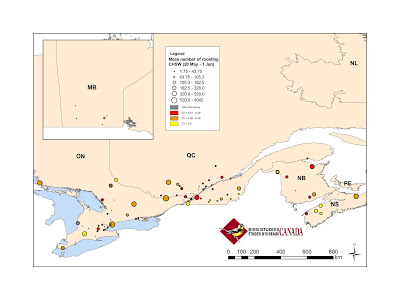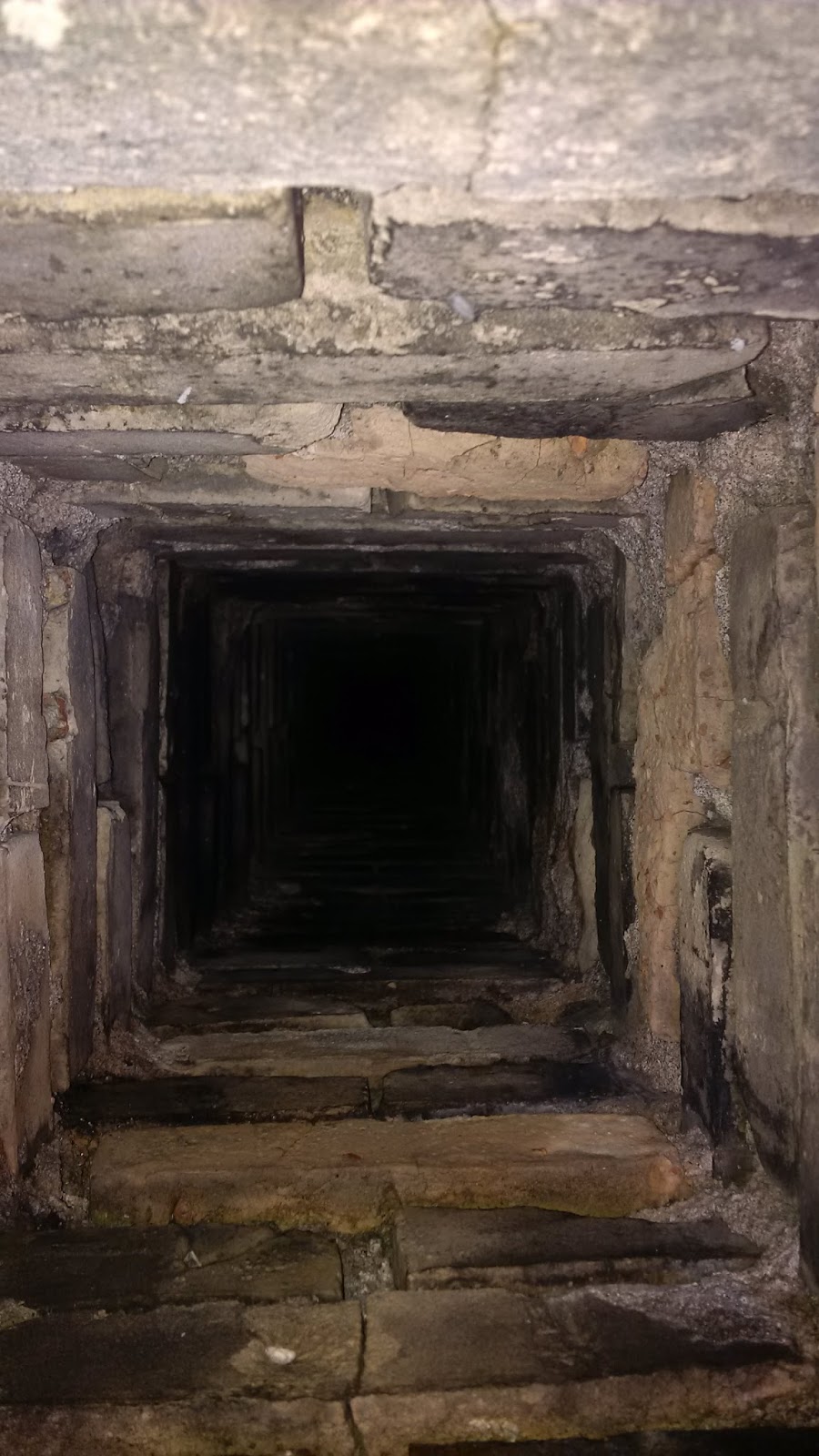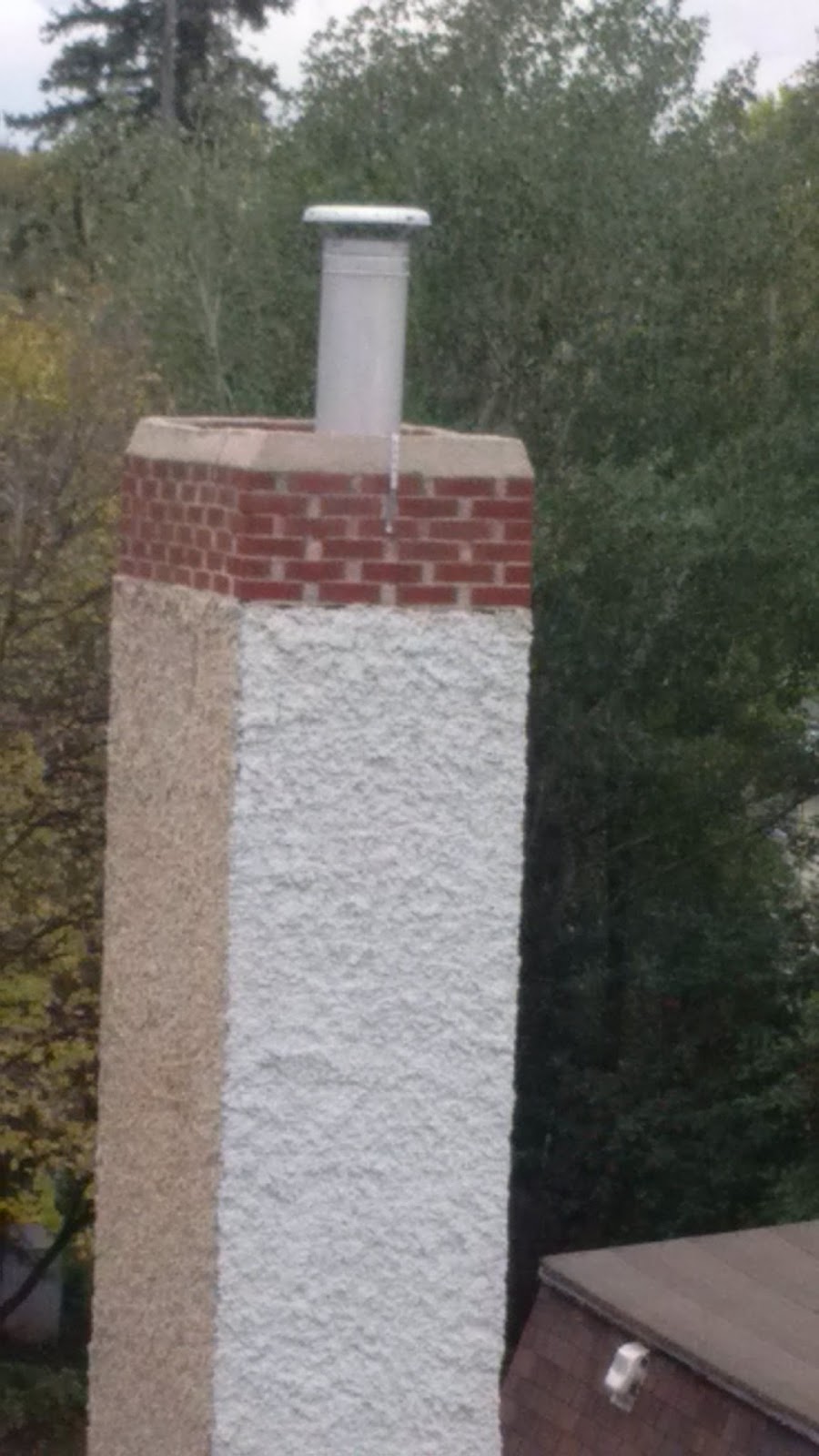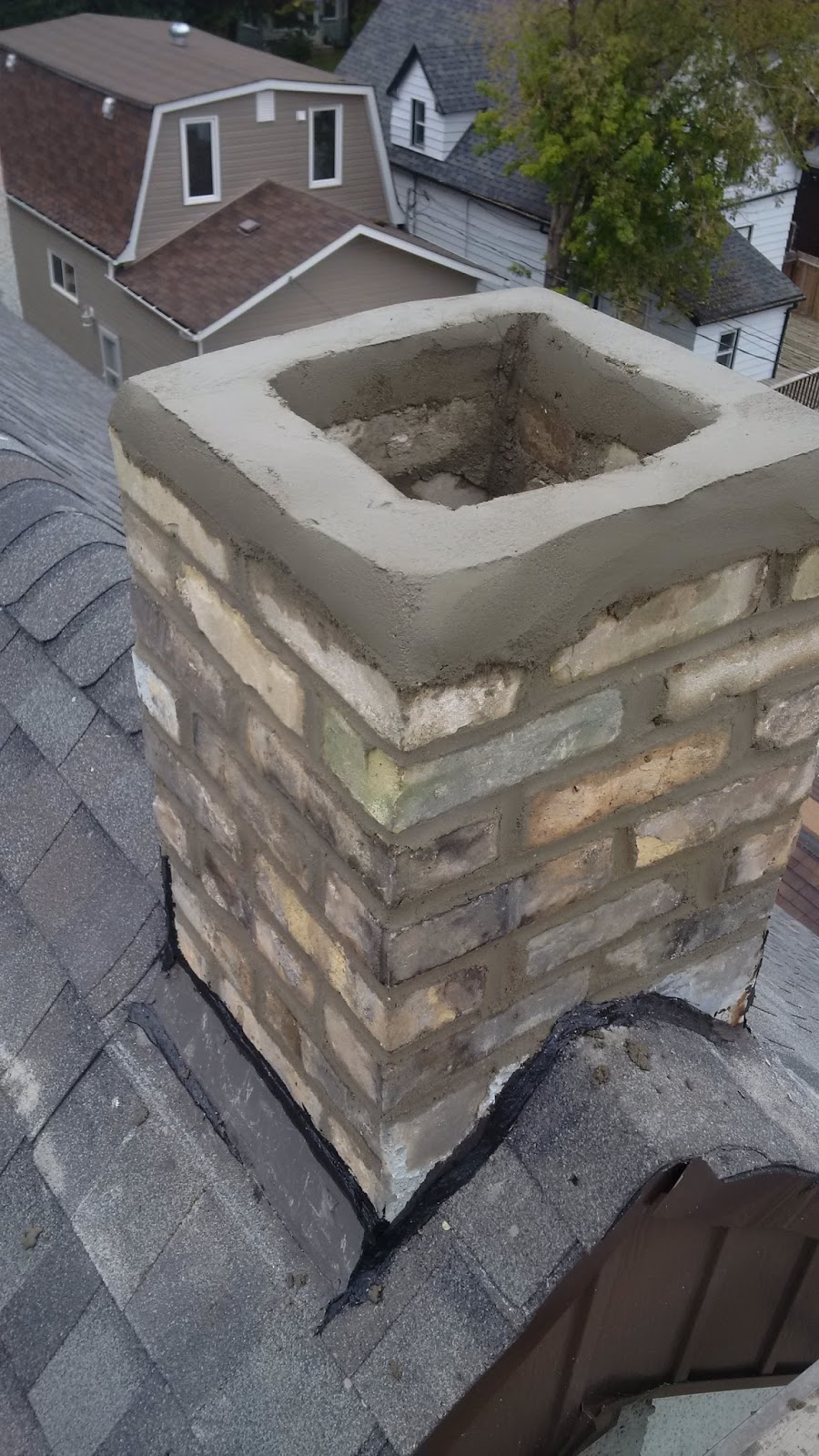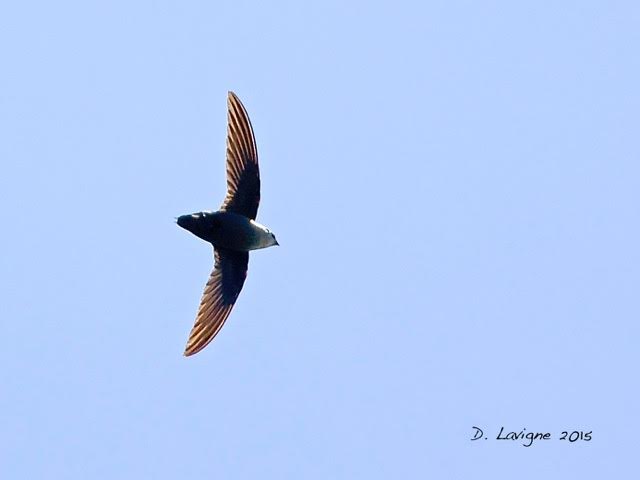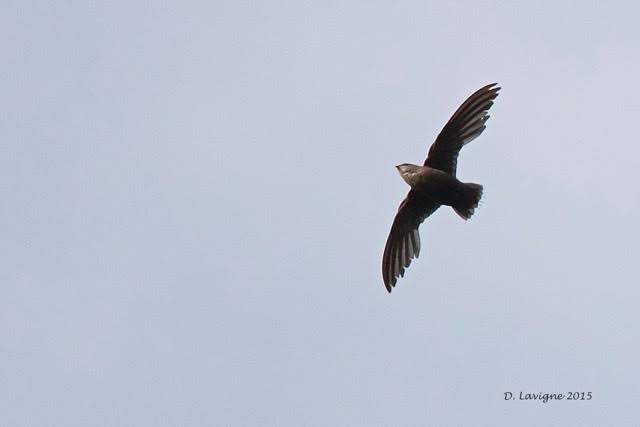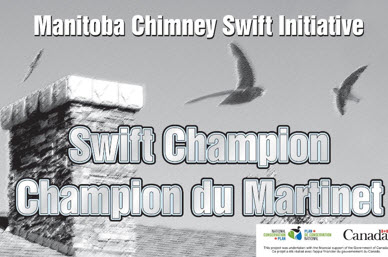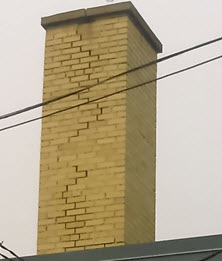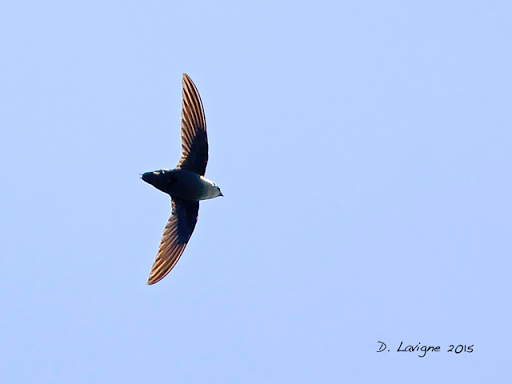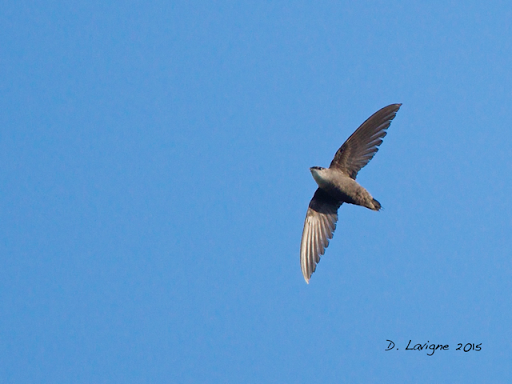SATURDAY, AUGUST 1, 2015. The day started with promise. It was a lovely, sun-drenched morning with light winds. What a perfect start to a once in a lifetime experience which followed. After 9 monitoring seasons involving over 1,000 hours of chimney rim staring, I witnessed fledging for the first time!
Here is a synopsis of the monitoring session at the St. Adolphe Catholic Church, which spanned 8:50 to 10:50 AM:
8:50 monitoring session starts
8:51:29 exit
9:02:30 entry
9:04:54 exit
9:06:47 entry
9:16:20 entry (2 adults in now)
9:19:10 exit, exit (2 adults out together)
9:19:33 exit = low, fluttery wing beats = A FLEDGLING – JUVENILE No. 1; 2 adults and juvenile no. 1 fly together east, low over cemetery with the adults leading
9:34 juvenile and 1 adult fly together low over cemetery with the adult leading
9:41:XX exit = JUVENILE No. 2
9:47:03 juvenile flies north to south, alone
10:07:05 juvenile (can see intact wing margins) overhead west to east, alone
10:17 three swifts fly east to west on approach to chimney rim
10:17:45 2 adults enter + 1 juvenile misses entry – see the video link; juvenile flies to N then NE
10:17:55 1 adult exits and flies toward the juvenile
10:18:37 1 adult exits to SE
10:19 1 adult and 1 juvenile fly north of Church
10:39:45 entry; fast, easy = adult
10:40:47 exit; adult – see moulting on trailing wing edge
10:45 adult with juvenile following closely (within 1/2 body length) approach the chimney rim from the east
10:45:54 entry by adult; entry by slightly hesitant juvenile
10:46:43 exit by adult; fast, to east
10:50 monitoring session stops. Four consecutive exits indicated two fledglings were airborne this morning. Slow, fluttery flying and intact wing margins supported the identification of juveniles. Viewing a missed entry into the chimney was a bonus and there is footage of this amazing event!
Follow this link (to YouTube) to view a short video clip of two adult chimney swifts leading a fledgling back to the home chimney at the St. Adolphe Catholic Church ~ 10:17 am, Saturday, August 1, 2015.
It takes more than good luck to make the most of a chimney swift monitoring season which captures such rare events. Many people support my swift watching habits and reports. THANKS to Rob, Duncan, and Ryan who are my puppy-sitting and tech support team. THANKS also to Frank for bringing all the news to you as our webmaster. Much appreciated early season monitoring support for the five St. Adolphe nest sites came from Ken, Lewis, Roberta, Frank, Jacquie, Kathy, and Rob.
Now jumping back to the days leading up to fledging day, adult activity at the Church nest site was high. Monitoring sessions which took place in the morning, for at least an hour, between 8:30 and 11:30 showed: 6 entry/exit cycles an hour – July 26; 7 entry/exit cycles an hour – July 30; and 7 entry/exit cycles an hour – July 31. After fledging, a “robust roosting hour” session on Aug. 3 did not pick up an increased head count – two adults roosted for the night; it may take several days before the youngsters are out foraging during the evening. Once the pesky string of nighttime thunder storms subsides, another attempt will be made to get a post-fledging count to confirm the number of fledglings at the Church nest site.
Despite the very good outcome at the Church, overall, the 2015 nesting season has been problematic for the St. Adolphe chimney swifts. Of 5 available nest sites in town, only 4 were occupied this year. Breeding adults returned later in May than in most previous years and nest building began close to (or after) the June 1 “cut-off” date for possible successful outcomes. Indeed, the Brodeur Bros. pair was the last to start their nest around June 7-9 and was one of the unsuccessful couples. Nest failures are indicated when breeding adults stop using the chimneys during the daytime. This occurred at: Main St. between July 7-12; Brodeur Bros. on July 14; and at the NE Club Amical between July 17-24.
What went wrong with the nesting attempts in 2015? Heavy rain storms seemed to arrive weekly and the Main St. swifts stopped using the chimney within a day of a Saturday night deluge. Nests can wash off the interior surfaces of chimneys and insects (chimney swift food) can be washed out of the air column with sustained rains. Insect abundance can also be reduced by prolonged weather patterns involving high temperature/humidity – these systems cannot be controlled. Reduced food availability also may be related to insecticide use. The St. Adolphe area lies within the mosquito abatement area for the City of Winnipeg and it is also embedded in agricultural lands where soybean aphids are controlled through the aerial spraying.
It will take a lot of intensive study to tease apart the contributing factors to nest failures. However, based on the recent monitoring results in St. Adolphe, it appears that the general population decline of chimney swifts may not be occurring entirely due to the lack of habitat.
Now to add in monitoring data from other communities…more good news flew in from Margaret and Millie and their alternate monitor Louanne. They have been rewarded for their diligent nightly sessions at Site 900 in Brandon. On August 3, 8 entry/exit cycles were made before 2 adults roosted for the night. On August 4, roosting hour observations indicated an entry by an inexperienced swift ~ likely a juvenile. Between 9:17-9:18 PM, Millie and Margaret noted ” Two attempts i.e. a dive and a pull-up. Finally made it into the chimney on the third attempt.” It is likely that the 2015 nesting attempt at this Brandon site has been successful!
Monitoring of roost sites indicated an increase in chimney swift abundance by mid-July. Roosting hour counts at Assiniboine School = 34 on July 1 and 69 on July 19. In Selkirk, the big roost had 19 swifts in for the night of July 20 and 28 swifts in for the night of July 27. The swifts are on the move now…
By mid-August, a profound redistribution of the Manitoba chimney swift population will take place. In St. Adolphe, successful fledging seems to trigger a “release” of unsuccessful adults from the community. In previous years, the local birds have gathered at the Church (when the site had successful fledging) or left the community altogether (this happened in years with poor food supply = extremely low rates of entry/exit cycles = low feeding rates of juveniles, which resulted in the majority of nesting attempts failing). Ken, in Dauphin, usually expects his swifts to be gone from the roost site by August 18.
So, if you want to enjoy some “last looks” before the swifts head south, head out to your favourite chimney soon!
Happy swifting, Barb.
